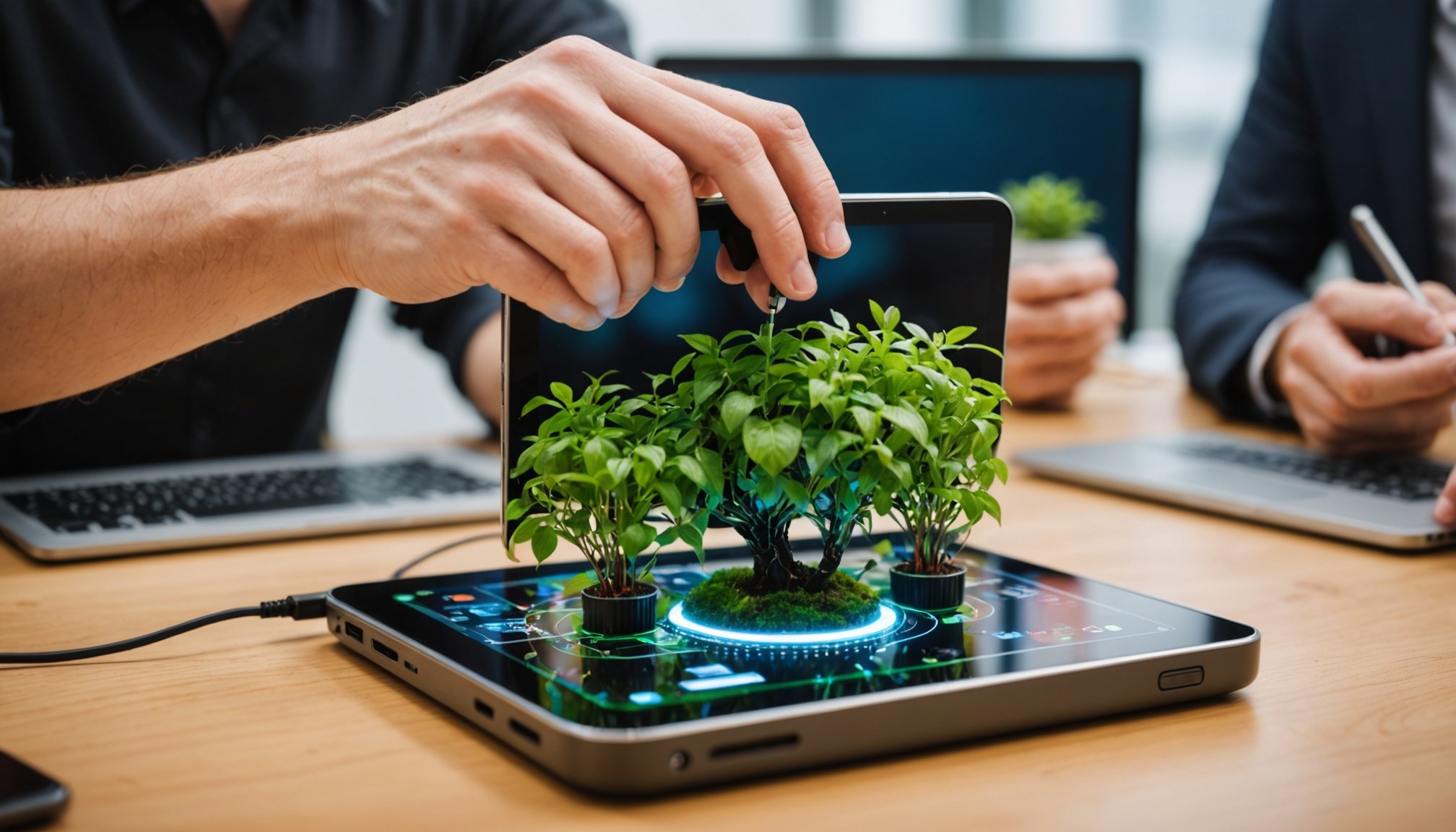Unveiling Cutting-Edge Sustainable Consumer Electronics Trends in the UK
As the world hurtles towards a more sustainable future, the UK is at the forefront of innovation in consumer electronics, driven by stringent government policies, technological advancements, and a growing eco-conscious consumer base. Here, we delve into the cutting-edge sustainable consumer electronics trends that are set to shape the UK in 2025.
Renewable Energy and Sustainable Design
The UK’s commitment to reaching Net Zero by 2050 is driving significant changes in the consumer electronics industry. One of the key trends is the integration of renewable energy sources into the production and operation of electronic devices.
Have you seen this : Maximize comfort: air source heat pump installation in croydon
Green Computing and Energy-Efficient Hardware
Companies like Lenovo are leading the charge in sustainable PC design. According to Mary Jacques, executive director of global ESG and regulatory compliance at Lenovo, “In 2025, businesses will increasingly seek devices designed for longevity and maximum upgradeability, driving a stronger shift toward a more circular economy and sustainability in the tech industry.”[2]
- Modular Designs: Laptops and other devices are being designed with modularity in mind, allowing for easy repair and upgrades. This reduces the need for frequent replacements and minimizes electronic waste.
- Durable Materials: The use of durable materials enhances the longevity of devices, reducing the environmental impact associated with frequent replacements.
- Recycled Components: There is a growing use of recycled or recyclable components to reduce product carbon footprints and improve overall recyclability.
The Circular Economy in Tech
The circular economy is a cornerstone of sustainable practices in the consumer electronics industry. This approach focuses on reducing waste, reusing materials, and recycling.
Also to see : Essential guide to air source heat pump setups in Croydon
Extended Producer Responsibility (EPR)
The UK government’s EPR legislation holds producers accountable for the entire lifecycle of their products. This incentivizes companies to design goods that are easier to recycle or repair. Here are some key aspects of the circular economy in tech:
- Repairable Devices: Designs with accessible instructions and simplified disassembly are becoming more widespread. This encourages consumers to repair rather than replace devices.
- Take-Back Programs: Many companies are implementing take-back programs for material recovery and reuse, further reducing electronic waste.
- Biodegradable Packaging: The shift away from single-use plastics is evident in the adoption of biodegradable and reusable packaging solutions, aligning with the UK Plastics Pact[1].
Smart Home and IoT Innovations
Smart home technologies and the Internet of Things (IoT) are revolutionizing how we live and interact with our environment.
Edge Computing and Real-Time Data Processing
Edge computing is a game-changer in IoT applications, processing data closer to where it is generated. This reduces latency, improves efficiency, and minimizes the energy footprint of data handling.
- Smart Cities: IoT and artificial intelligence (AI) are being integrated into smart city initiatives to optimize energy use, traffic flow, and waste management. These technologies create efficient, sustainable, and livable urban environments[4].
- Smart Home Devices: High-tech smart home devices are becoming more energy-efficient and eco-friendly. For example, smart thermostats and energy management systems use AI to optimize energy consumption in real-time.
Consumer Behaviour and Lifestyle Changes
UK consumers are increasingly driving demand for sustainable products and services, influencing the consumer electronics industry in several ways.
Eco-Friendly Fashion and Electronics
The slow fashion movement is gaining momentum, with consumers prioritizing durable, ethically made clothing over fast fashion. Similarly, in consumer electronics:
- Second-Hand Economy: Online platforms for resale, rental, and refurbishment of electronics are flourishing. Consumers are opting for pre-owned goods in electronics, reducing the demand for new, resource-intensive products[1].
- Carbon Footprint Awareness: Digital tools and apps are helping individuals track and reduce their carbon footprints, empowering them to make greener choices.
Practical Insights and Actionable Advice
For consumers looking to embrace these sustainable trends, here are some practical tips:
Choosing Sustainable Products
- Look for Modular Designs: Opt for devices that are designed for easy repair and upgrades.
- Check for Recycled Components: Choose products made with recycled or recyclable materials.
- Energy Efficiency: Select devices with energy-efficient hardware and extended software support.
Supporting Circular Economy Practices
- Participate in Take-Back Programs: Return old devices to manufacturers or retailers that offer take-back programs.
- Buy Second-Hand: Consider purchasing pre-owned electronics to reduce demand for new products.
- Use Biodegradable Packaging: Support companies that use biodegradable and reusable packaging solutions.
Challenges and Future Outlook
While these trends highlight the UK’s commitment to sustainability, there are challenges ahead.
Policy Gaps and Funding
Ensuring consistent policies and adequate funding to support green initiatives will be critical. The government needs to maintain a strong regulatory framework to encourage innovation and investment in sustainable technologies.
Balancing Transition Costs
Balancing the costs of transitioning to renewable energy and sustainable practices with affordability for households and businesses is a complex task. The industry must work closely with the government to find solutions that are both sustainable and economically viable.
Table: Comparative Analysis of Sustainable Consumer Electronics Trends
| Trend | Description | Key Players | Impact |
|---|---|---|---|
| Renewable Energy | Integration of renewable energy sources into production and operation. | Lenovo, UK Government | Reduced carbon footprint, increased energy efficiency. |
| Circular Economy | Focus on reducing waste, reusing materials, and recycling. | UK Government, Manufacturers | Reduced electronic waste, increased resource efficiency. |
| Smart Home and IoT | Use of IoT and AI to optimize energy use and reduce waste. | Smart City Initiatives | Efficient, sustainable urban environments. |
| Consumer Behaviour | Increased demand for sustainable products and services. | Consumers, Online Platforms | Reduced demand for new products, increased use of second-hand goods. |
| Edge Computing | Processing data closer to the source to reduce latency and energy consumption. | Tech Companies | Improved efficiency, reduced energy footprint. |
Quotes and Expert Insights
- “Sustainability is no longer a choice—it’s a mandate. Technology will continue to play a pivotal role in enabling green practices and solutions,” says Olivia Pickering, Marketing Executive at DTP Group[3].
- “In 2025, businesses will increasingly seek devices designed for longevity and maximum upgradeability, driving a stronger shift toward a more circular economy and sustainability in the tech industry,” notes Mary Jacques, executive director of global ESG and regulatory compliance at Lenovo[2].
The UK is poised to lead the way in sustainable consumer electronics trends in 2025, driven by innovative technologies, government initiatives, and changing consumer behaviour. As we move forward, it is crucial to address the challenges ahead, ensure consistent policies, and balance the costs of transition. By embracing these trends and adopting sustainable practices, we can create a greener, more resilient future for all.
In this world of high-tech innovation, the integration of renewable energy, circular economy practices, and smart home technologies is not just a trend but a necessity. As consumers, businesses, and policymakers work together, we can harness the power of technology to mitigate climate change, reduce environmental impact, and build a sustainable future. The future is indeed green, and it starts with the choices we make today.











